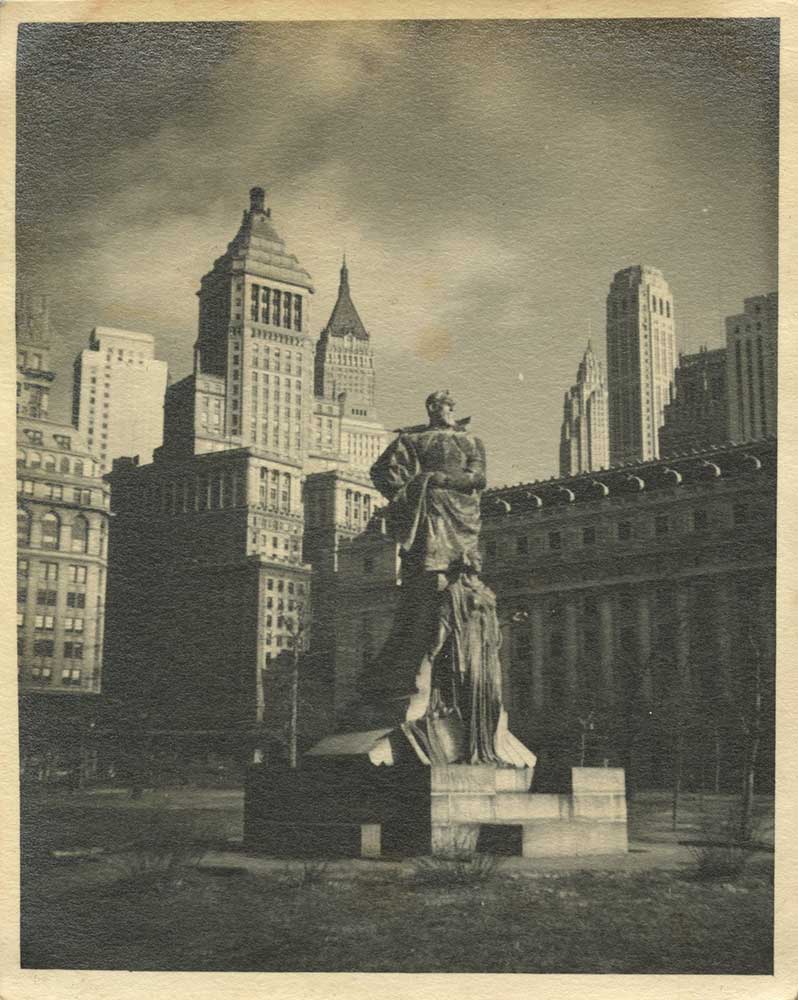
Alexander Artway
Untitled (Statue in New York City) by Alexander Artway
 Toronto, ON)
Toronto, ON)
Learn about our Shipping & Returns policy.
Have a question? Read our FAQ.
- Artwork Info
- About the Artist
- Artist News
-
circa 1935
Gelatin silver print
Annotated, "18 ¾ f8 proxar 1m 45s V. Proj #3, 23 f8 no proxar 40s + 10s - 20s, Bros. Med, try Bros hard", in ink, au verso
Printed circa 1935 -
Alexander Artemiev was born March 25, 1903 in Gomel, Belarus, Russia. He was the youngest child of nine children. His prosperous family educated him in the gymnasium (prep school) where his older brother was the principal. Russia was in great turmoil in 1917, and Alexander, as well as so many others, was caught up in these changing times. He fought as a young teenager in the White Army. He said he liked the uniform and had to do this for his family’s land and property. In the army he was wounded in his left leg, which gave him trouble all his later life. He fled and went into exile for many years in Europe (Belgrade, Prague, Paris), until he was able to enter America. He arrived at Ellis Island in June of 1922 under the name Alexander Artway.
For the next 18 years Artway remained in New York City. He had to learn a new life; adjusting from living on a sprawling Russian farm to very close urban quarters. He worked more with his hands than with his mind, since his European degrees were meaningless in the United States. Away from all family but his brother John (Sergei), Alexander had to seek out new connections. He found Lena, a woman whose family was still in Ukraine. The two explored the city together and carried on an affair that lasted many years.
From his photographs it appears he was both excited and lonely. From his letters we can see that he was very attached to his mother and family back home. In fact, he returned to Russia in 1936 and ’37 to see them, a very risky business. The photographs from this trip to Gomel are touched by a tenderness and nostalgia found nowhere else in his work; they paint a picture of a man returning to his true roots. Even though he is pictured in these photographs in his New York City fine suits and hats, hair-‐line receding, one can spot a little boy’s grin in the photographs of Alex and his mother.
In New York, Artway was very fascinated by the skyscrapers going up. He recorded these buildings from every angle and rooftop, and perhaps even from airplanes. He attended and taught at NYU, taking a degree in architecture in 1934.
Before going to NYU (with the aid of an organization called the Russian Student Fund) he joined the Merchant Marines. He later became a captain of ships and sailed around the world taking pictures of the foreign lands he visited. There are many beautiful studies of skies, clouds, and the ocean. (It appears he may have studied Stieglitz, Abbott, etc.) He saw much more of the world than the average person of these times and led an unconventional life.
He documented New York City life yet avoided photographing people he did not know. He recorded city streets, friends, his love life, animals, churches, and of course, architecture. His eye was unique, and his negatives are marked by a modernist aesthetic with a touch of pictorialist romanticism. He photographed nearly compulsively for about 15 years and only slowed down after the birth of his first child. In Philadelphia he became a true family man, and the photographs after 1942 are reflective of Artway’s new identity.
It seems unlikely Artway could have imagined the form which his photographs now take. For him, they were a record of his life, of the compositions he saw around him, of a life well-‐lived. Now they form the Alexander Artway Archive made up of 4,000 negatives and 3,000 prints all neatly organized in plastic sleeves and black boxes. These are his legacy to his daughter Jeanette. The photographs from Russia, the portraits of his family and friends have become her heritage and her link to a family she’s never known. Now, as we begin to share these images with the public, we hope the photographs will become the heritage of many others. They tell the story of the trials and triumphs of an adventurous immigrant forging a life in America.
-
Artway’s vintage prints have recently been organized by his daughter and have been shown successfully at art fairs in Los Angeles as well as in New York City.


